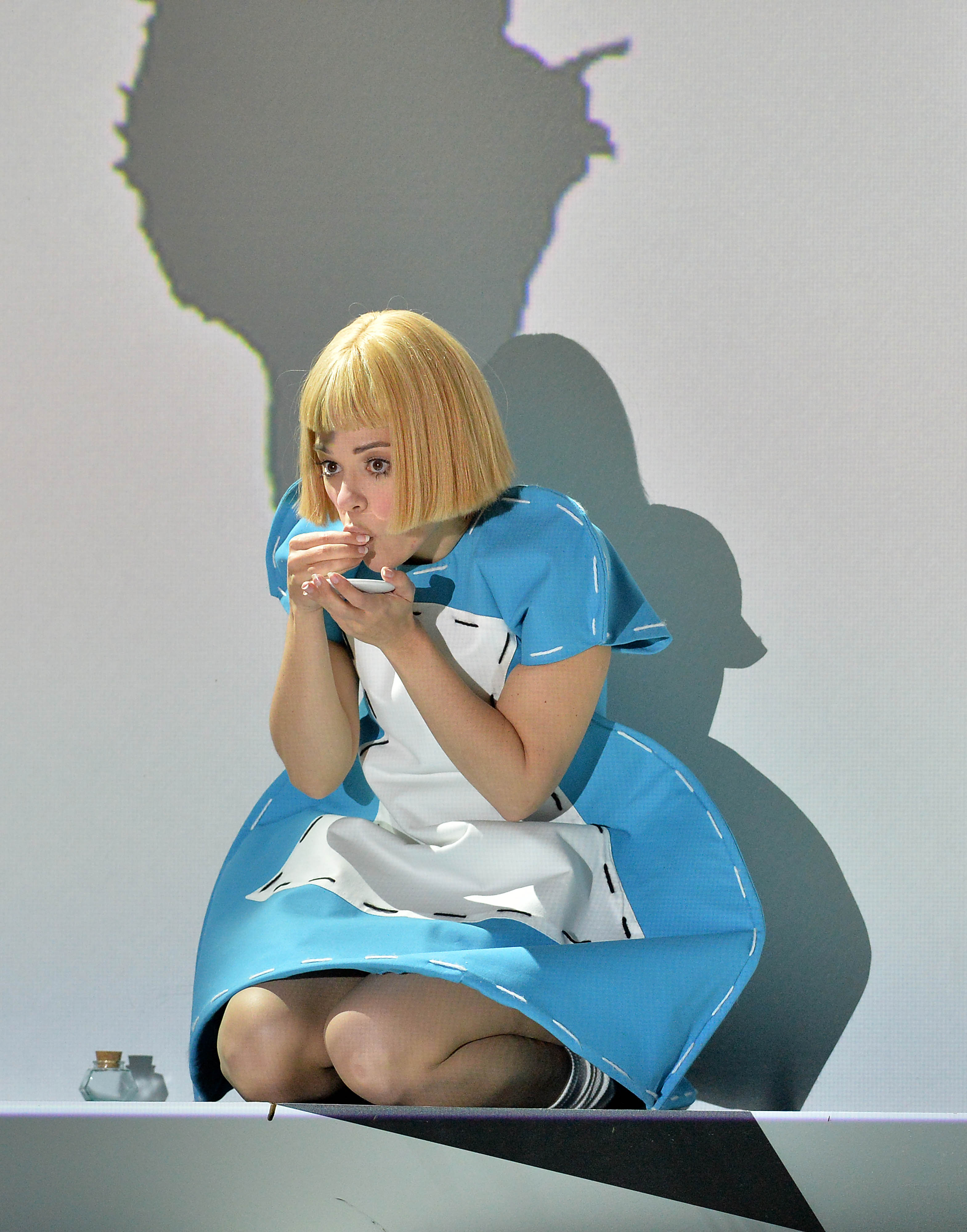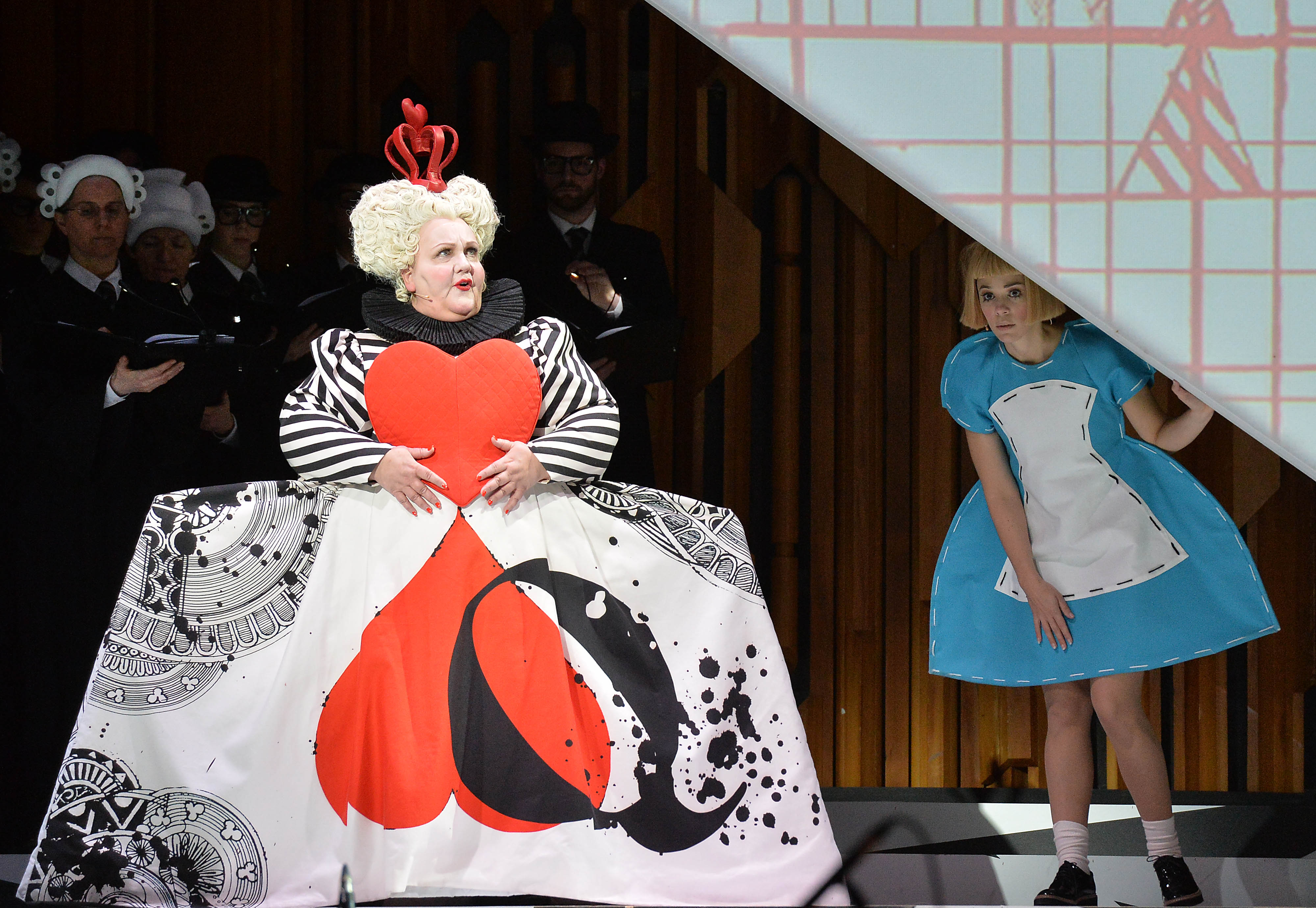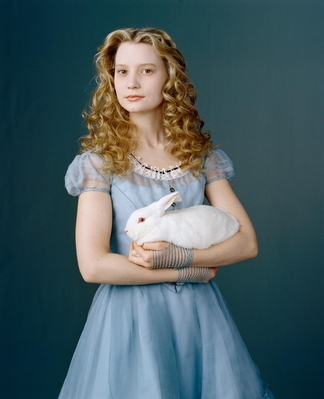Alice in Wonderland, BBCSO, Brönnimann, Barbican | reviews, news & interviews
Alice in Wonderland, BBCSO, Brönnimann, Barbican
Alice in Wonderland, BBCSO, Brönnimann, Barbican
A curious tale gets a riotous musical telling
The Southbank Centre’s Women of the World Festival may have been the largest cultural event marking International Women’s Day 2015, but it wasn’t the most ambitious. Over at the Barbican two women were responsible for a multimedia opera staging whose spectacle, level of detail and sheer force of personnel involved was staggering.
Premiered in 2007, Unsuk Chin’s Alice in Wonderland has already had more outings than most contemporary operas. You could attribute this to the endless appeal of Lewis Carroll’s story, but it also has an awful lot to do with Chin’s witty, sonically imaginative and disquieting score. For this new production, staged for brief runs in both Los Angeles and London, Chin’s music is paired with the meticulous creativity of British director-designer Netia Jones to create a multimedia spectacle that transforms the sombre interior of the Barbican Hall into a riot of colour and sensation.
Jones takes Ralph Steadman’s acid 1970s pen and ink illustrations of Alice as her touchstone
A giant screen, poised diagonally on one corner as though dropped from a great height, fills the back of the stage, propped up by a luckless red-suited flunky, while the floors are patterned in zany monochromes. Even the orchestral musicians themselves (placed centre stage) aren’t exempt from Jones’s touch, each sporting a number on the back of their tail coats. One crawls determinedly around on the floor as the audience enters. Searching for something? You learn quickly not to ask why, just to surrender to whatever unfolds.

Jones takes Ralph Steadman’s acid 1970s pen and ink illustrations of Alice as her touchstone, bringing many to life as animations, and taking others as inspiration for costumes (brilliantly fashioned by Jemima Penny) and characters. Colours are primary, designs are remixed, trippy versions of traditional styles, exaggerated and distorted for comic effect. The Queen of Hearts (the suitably stentorian Jane Henschel) sports a ruff wide enough to take out anyone in a two-metre radius, while the Duchess (Jenni Bank) bulges and balloons in a costume that makes a mockery of a woman’s curves. There’s little of the cosy storybook here; the Mad Hatter and his companions wear something that comes very close to a straitjacket, while croquet-mallet flamingos bleed copiously on contact with the hedgehog balls.

Chin might get away with this if the work were trimmed back. After an initial burst of novelty and invention things do drag, especially in the courtroom scene, and could usefully have been tightened for this revival while the orchestration (reduced here, to fit the space) was being altered. There’s also a disproportionate emphasis on high, almost electronic sonorities. A combination of vocal glissandi, coloratura sopranos and upper strings and woodwind find those same denatured musical vibrations we recognise from Ligeti, deploying them a little mercilessly. Even the double basses pluck so hard their notes become brightly snapping textures, or strike their strings col legno for another brittle, tinkling sound.
Though contending with some rather crude amplification which flattens all the voices out, the cast sell every bar. From the warm purity and agility of Gilmore’s delivery, to Bank’s maniacal, glittering Duchess and the wonderful boys of the Tiffin Choir, they give surreal without overworking it – a delicate balance, and one Jones herself also triumphs at. This trip down the musical rabbit-hole is not without its storm clouds, but its creative ingenuity and invention, visual and musical, still make the journey a vivid and an entertaining one.
ALICE'S ADVENTURES ON STAGE AND SCREEN
Alice, Scottish Ballet. It should be a capital crime to attempt an Alice ballet - off with their heads
Alice's Adventures in Wonderland, Royal Ballet. Even the best butter would not help this plot-less evening
Alice's Adventures Under Ground, Barbican. Gerald Barry's crazy velocity berserks both Alice books in rude style
 Alice in Wonderland. Tim Burton takes on the fantasy classic
Alice in Wonderland. Tim Burton takes on the fantasy classic
Alice Through the Looking Glass. Mia Wasikowska (pictured), Helena Bonham Carter and Johnny Depp back in inventive if unfaithful Carroll sequel
Jan Švankmajer's Alice. The great Czech animator's remarkable first full-length film
wonder.land, National Theatre. Damon Albarn’s Alice musical has fun graphics, but a banal and didactic storyline
rating
Explore topics
Share this article
The future of Arts Journalism
You can stop theartsdesk.com closing!
We urgently need financing to survive. Our fundraising drive has thus far raised £49,000 but we need to reach £100,000 or we will be forced to close. Please contribute here: https://gofund.me/c3f6033d
And if you can forward this information to anyone who might assist, we’d be grateful.

Subscribe to theartsdesk.com
Thank you for continuing to read our work on theartsdesk.com. For unlimited access to every article in its entirety, including our archive of more than 15,000 pieces, we're asking for £5 per month or £40 per year. We feel it's a very good deal, and hope you do too.
To take a subscription now simply click here.
And if you're looking for that extra gift for a friend or family member, why not treat them to a theartsdesk.com gift subscription?
more Opera
 La bohème, Opera North review - still young at 32
Love and separation, ecstasy and heartbreak, in masterfully updated Puccini
La bohème, Opera North review - still young at 32
Love and separation, ecstasy and heartbreak, in masterfully updated Puccini
 Albert Herring, English National Opera review - a great comedy with depths fully realised
Britten’s delight was never made for the Coliseum, but it works on its first outing there
Albert Herring, English National Opera review - a great comedy with depths fully realised
Britten’s delight was never made for the Coliseum, but it works on its first outing there
 Carmen, English National Opera review - not quite dangerous
Hopes for Niamh O’Sullivan only partly fulfilled, though much good singing throughout
Carmen, English National Opera review - not quite dangerous
Hopes for Niamh O’Sullivan only partly fulfilled, though much good singing throughout
 Giustino, Linbury Theatre review - a stylish account of a slight opera
Gods, mortals and monsters do battle in Handel's charming drama
Giustino, Linbury Theatre review - a stylish account of a slight opera
Gods, mortals and monsters do battle in Handel's charming drama
 Susanna, Opera North review - hybrid staging of a Handel oratorio
Dance and signing complement outstanding singing in a story of virtue rewarded
Susanna, Opera North review - hybrid staging of a Handel oratorio
Dance and signing complement outstanding singing in a story of virtue rewarded
 Ariodante, Opéra Garnier, Paris review - a blast of Baroque beauty
A near-perfect night at the opera
Ariodante, Opéra Garnier, Paris review - a blast of Baroque beauty
A near-perfect night at the opera
 Cinderella/La Cenerentola, English National Opera review - the truth behind the tinsel
Appealing performances cut through hyperactive stagecraft
Cinderella/La Cenerentola, English National Opera review - the truth behind the tinsel
Appealing performances cut through hyperactive stagecraft
 Tosca, Royal Opera review - Ailyn Pérez steps in as the most vivid of divas
Jakub Hrůša’s multicoloured Puccini last night found a soprano to match
Tosca, Royal Opera review - Ailyn Pérez steps in as the most vivid of divas
Jakub Hrůša’s multicoloured Puccini last night found a soprano to match
 Tosca, Welsh National Opera review - a great company reduced to brilliance
The old warhorse made special by the basics
Tosca, Welsh National Opera review - a great company reduced to brilliance
The old warhorse made special by the basics
 BBC Proms: The Marriage of Figaro, Glyndebourne Festival review - merriment and menace
Strong Proms transfer for a robust and affecting show
BBC Proms: The Marriage of Figaro, Glyndebourne Festival review - merriment and menace
Strong Proms transfer for a robust and affecting show
 BBC Proms: Suor Angelica, LSO, Pappano review - earthly passion, heavenly grief
A Sister to remember blesses Puccini's convent tragedy
BBC Proms: Suor Angelica, LSO, Pappano review - earthly passion, heavenly grief
A Sister to remember blesses Puccini's convent tragedy
 Orpheus and Eurydice, Opera Queensland/SCO, Edinburgh International Festival 2025 review - dazzling, but distracting
Eye-popping acrobatics don’t always assist in Gluck’s quest for operatic truth
Orpheus and Eurydice, Opera Queensland/SCO, Edinburgh International Festival 2025 review - dazzling, but distracting
Eye-popping acrobatics don’t always assist in Gluck’s quest for operatic truth

Add comment